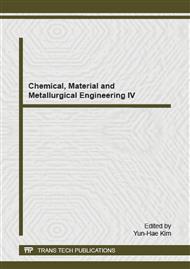p.49
p.53
p.57
p.61
p.68
p.72
p.76
p.82
p.86
Preparation of Chitosan Nanospheres by Miniemulsion Crosslinking Method
Abstract:
Objective To obtain immobilized nanomaterials with good performance, the preparation condition of chitosan nanospheres by miniemulsion crosslinking method was optimized. Methods The chitosan nanospheres were synthesized by miniemulsion crosslinking method with Span80 and Tween80 as the emulsifier, glutaraldehyde as the crosslinker, n-hexane and paraffin liquid as oil phase,chitosan acetic acid solution as aqueous phase. The particle size was measured by Zetasizer nanoanalyzer. Results The results of the univariate tests show that the optimal preparation condition of chitosan nanospheres can be obtained when water/oil volume ratio is 3:2. The size distribution of chitosan nanospheres is 18.17nm to 190.1nm. Conclusion The chitosan nanospheres by miniemulsion crosslinking method are suitable materials as enzymes and proteins immobilized carrier.
Info:
Periodical:
Pages:
68-71
Citation:
Online since:
March 2015
Authors:
Price:
Сopyright:
© 2015 Trans Tech Publications Ltd. All Rights Reserved
Share:
Citation:


